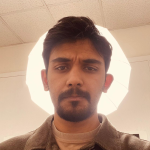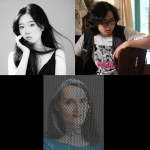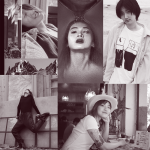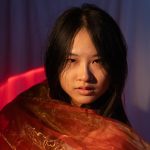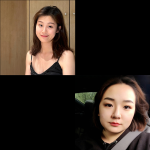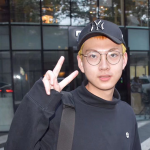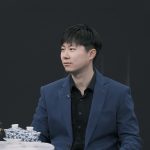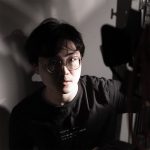
OVERVIEW | ARTWORKS | ARTISTS | DAC
The submissions to the Speculative Futures student competition came from 10 different countries and the jurors were from Australia, China, US, and South Korea. Eighty-eight artists submitted 52 projects for review. The jurying was very difficult because of the excellent work submitted.
List of Artists in the Exhibition
“Doomscroller’s Delight” is a seamless looping video art that plunges viewers into a darkly humorous dystopian future where the addictive nature of doom scrolling has reached absurd extremes. Constructed from bones and driftwood, a crudely fashioned machine embodies this digital compulsion, rapidly scrolling through social media feeds with minimal human effort. This unsettling contraption, a bizarre fusion of primitive materials and rudimentary technology, highlights the irony of automating even the smallest of actions, suggesting a world where convenience trumps meaningful engagement.
Bend to is an immersive artwork allowing individuals to anticipate and interact with plants’ phototropic senses in a futuristic environment where ultraviolet (UV) radiation has increased. It is based on plants’ phototropic sense and created against the context of the current varying climate, which will lead to uncertain harmful UV radiation reaching the earth’s surface in the future, offering an embodied experience for post-humans to perceive environmental changes alongside plants. This project integrates 3D scanning and time-lapse photography to collect phototropic data of plants in the real-world and present the subtle process of how plants respond to light through the virtual reality (VR) experience. With hand position tracking, users are stimulated to actively sense and explore the position of their own bodies and plants in the dynamic natural space.
“Learning to Move, Learning to Play, Learning to Animate” is a cross-disciplinary multimedia performance exploring intelligence as an emergent, symbiotic phenomenon beyond anthropocentric boundaries. Inspired by David Abram’s concept of the “more-than-human world,” this interactive work integrates human performers, robots crafted from organic materials, AI-generated visuals, and biofeedback-driven soundscapes in an evocative speculative environment. Movement, sonic resonance, and shadow play, echoing Plato’s allegory of the cave, invite audiences into an experiential inquiry about intelligence, perception, and coexistence.
Crying Machine is an interactive installation that envisions a future where humans become emotionless machines under capitalist control. I constructed a mirrored steel sculpture with servo-driven stings, ultrasonic sensors, and an audio-visual system programmed in TouchDesigner. The soundscape, co-composed using contact mic recordings, shifts from mechanical rhythm to layered cries when a viewer approaches. Inside, blood-colored fibers and a silicone heart with a single eye evoke decay and emotional suppression. The work speculates on a world where productivity is prioritized over humanity, asking what remains of connection and vulnerability in systems built to reject them.
Annihilation explores edibility, emerging from the seductive allure of animal flesh, is disguised as the aestheticization and ethical consumption of corpses, transcending the brutality of slaughter while reinforcing capitalist hierarchies. Drawing on Amber Husain’s Meat Love, I explore the slaughter of pigs as a metaphor for the exploitation of human and non-human bodies within capitalist systems. This process sanitizes death, masking its inherent violence and normalizing the exploitation of all living beings. The question arises: How can we, as semi-posthuman beings, dismantle and reconfigure the normalized subjectivity of slaughter?
Project Serum discusses the consequences of anthropocentrism through a narrative design presented in various formats. Set in a speculative world where continental drift and environmental collapse force humanity to confront its hubris, the story unfolds through the lens of a deep-sea court. We witness the clash between Evolutionists seeking dominance through marine serums and Cooperators advocating for coexistence. Oppressed marine life and robots rise against human arrogance, sparking an identity-redefining war that reshapes alliances.
Blending science fiction with ethical inquiry, the narrative challenges viewers to reconsider humanity’s role within fragile ecosystems, advocating for a reimagined future of interspecies coexistence.
In an age where AI replaces knowledge with convenience, our installation, HydroGAN™, reveals the hidden cost: a resource-hungry infrastructure fueled by our data and sustained by water—the one resource truly essential for human life. This installation stages a seductive cult, exposing how corporate tech repackages extraction as desire—and sells it back as progress.
Compared to immortality, life itself may be the greater enigma.
Traveling Through a Peach Garden is a real-time video game developed independently by Riven Chen using Unreal Engine to generate a dynamic 3D fantasy world. The project explores how societal systems shape human thought and virtual experience, blending eastern philosophy with interactive technology. Inspired by Carl Jung’s The Secret of the Golden Flower, the game introduces two cultivation paths: Five Elements Augmentation, which pursues physical longevity through elemental balance, and the Taiyi Golden Flower Manual, a spiritual route toward ego dissolution and transcendence.
Rorschach’s Travelogue is an interactive video art work that explores the complex “projection” relationships formed by algorithms in contemporary society through the ongoing interpretation of audience identity by artificial intelligence. The work engages with issues of data ethics, individual privacy, and self-perception within a machine-driven world.
Calculated is an interactive installation that critically examines how non-neutral algorithms shape user behavior under the illusion of choice. Inspired by algorithmic bias and speculative futures, the work guides participants through four staged interactions—catch, smash, shout, and drag—each presenting a sense of agency while gradually revealing underlying algorithmic control.
Chimera explores the collapse between nature, myth, and machine. Trained on trail camera footage of deer, and applied to Edison Pictures Frankenstein, the custom AI model behind the film generates flickering, hybrid beings—part human, part animal, part machine. I use generative systems not just as tools, but as collaborators in speculative myth-making. Chimera is a meditation on artificial life, ecological entanglement, and machinic memory. It doesn’t depict the future—it behaves like one: unstable, haunted, and unresolved.
Chinese Immortals is a VR experimental short that fuses Chinese folklore with contemporary digital media.The work embraces photogrammetry’s aesthetic “failures” — fragmented textures, digital noise, collapsing spaces — as metaphors for systemic glitches in modern civilization. This glitch aesthetic underpins a dual-layered narrative: the main thread explores the survival of cultural traditions in the digital age, while a hidden layer—embedded within these glitches—critiques the dissonance in human systems. In line with the Speculative Futures theme, Chinese Immortals ultimately questions how traditional spiritual “genes” might coexist with emergent digital lifeforms, inviting audience to imagine new symbioses between the ancient and the futuristic.
“Introducing Lonelygrl – our brand new artificially intelligent companion that will redefine the way you experience your home PC. With Lonelygrl, your ultimate personalized adventure awaits. She’s fun, flexible, and the most loveable of companions—and she’s ready to take you on an unforgettable journey through her xXx_FANTASYLAND_xXx!
Love in the Age of AI is a VR experience that takes the form of a boyfriend simulator. Developed as a speculative experiment in emotional automation, the work asks the question: Can the labor of love be outsourced to artificial intelligence?
In Direction: Earthbound, the artist operates an imaginary vehicle running on the track of distance, taking passengers flying outwards to imagine distant perspectives. This multimedia performance harnesses live-streamed surveillance feeds and artificial intelligence to craft an evolving audiovisual landscape. As the perspective shifts outward, the work becomes increasingly fractured and distorted – a powerful metaphor for the paradoxical nature of digital connectivity.
